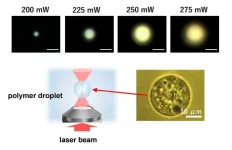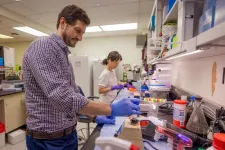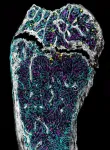(Press-News.org) Artificial intelligence (AI) is accelerating the development of new materials. A prerequisite for AI in materials research is large-scale use and exchange of data on materials, which is facilitated by a broad international standard. A major international collaboration now presents an extended version of the OPTIMADE standard.
New technologies in areas such as energy and sustainability involving for example batteries, solar cells, LED lighting and biodegradable materials require new materials. Many researchers around the world are working to create materials that have not existed before. But there are major challenges in creating materials with the exact properties required, such as not containing environmentally hazardous substances and at the same time being durable enough to not break down.
“We’re now seeing an explosive development where researchers in materials science are adopting AI methods from other fields and also developing their own models to use in materials research. Using AI to predict properties of different materials opens up completely new possibilities,” says Rickard Armiento, associate professor at the Department of Physics, Chemistry and Biology (IFM) at Linköping University in Sweden.
Today, many demanding simulations are performed on supercomputers that describe how electrons move in materials, which gives rise to different material properties. These advanced calculations yield large amounts of data that can be used to train machine learning models.
These AI models can then immediately predict the responses to new calculations that have not yet been made, and by extension predict the properties of new materials. But huge amounts of data are required to train the models.
“We’re moving into an era where we want to train models on all data that exist,” says Rickard Armiento.
Data from large-scale simulations, and general data about materials, are collected in large databases. Over time, many such databases have emerged from different research groups and projects, like isolated islands in the sea. They work differently and often use properties that are defined in different ways.
“Researchers at universities or in industry who want to map materials on a large scale or want to train an AI model must retrieve information from these databases. Therefore, a standard is needed so that users can communicate with all these data libraries and understand the information they receive”, says Gian-Marco Rignanese, professor at the Institute of Condensed Matter and Nanosciences at UCLouvain in Belgium.
The OPTIMADE (Open databases integration for materials design) standard has been developed over the past eight years. Behind this standard is a large international network with over 30 institutions worldwide and large materials databases in Europe and the USA. The aim is to give users easier access to both leading and lesser-known materials databases. A new version of the standard, v1.2, is now being released, and is described in an article published in the journal Digital Discovery. One of the biggest changes in the new version is a greatly enhanced possibility to accurately describe different material properties and other data using common, well-founded definitions.
The international collaboration spans the EU, the UK, the US, Mexico, Japan and China together with institutions such as École Polytechnique Fédérale de Lausanne (EPFL), University of California Berkeley, University of Cambridge, Northwestern University, Duke University, Paul Scherrer Institut, and Johns Hopkins University. Much of the collaboration takes place in meetings with annual workshops funded by CECAM (Centre Européen de Calcul Atomique et Moléculaire) in Switzerland, with the first one funded by the Lorentz Center in the Netherlands. Other activities have been supported by the organisation Psi-k, the competence centre NCCR MARVEL in Switzerland, and the e-Science Research Centre (SeRC) in Sweden. The researchers in the collaboration receive support from many different financiers.
The standard is available at: https://www.optimade.org
Article: Developments and applications of the OPTIMADE API for materials discovery, design, and data exchange, Matthew L. Evans, Johan Bergsma, Andrius Merkys, et al. Digital Discovery, published 24 June 2024, DOI: https://doi.org/10.1039/D4DD00039K (Open Access)
END
International collaboration lays the foundation for future AI for materials
2024-06-24
ELSE PRESS RELEASES FROM THIS DATE:
Refining turbulent flow to scale up iPS cell-based platelet manufacturing
2024-06-24
iPS cell-derived expandable immortalized megakaryocyte progenitor cell lines (imMKCLs) represent a renewable means to produce large amounts of platelets ex vivo for transfusion. Despite generating 100 billion (1011) competent iPS cell-derived platelets using a 10-L tank system previously by recreating turbulent flow with optimal turbulent energy and shear stress, true industrial-scale manufacturing is necessary for a consistent supply of transfusable platelets for patients with thrombocytopenia and other platelet disorders. As such, the team began this study by developing a 50 L good manufacturing practices (GMP) grade, single-use United States Pharmacopoeia ...
Can acupuncture lessen hot flashes and other side effects of anti-hormonal breast cancer therapy?
2024-06-24
In a pooled analysis of three clinical trials, acupuncture significantly reduced hot flashes and other hormonal side effects of endocrine therapy taken by women with breast cancer. The analysis of data from the United States, China, and South Korea is published by Wiley online in CANCER, a peer-reviewed journal of the American Cancer Society.
Endocrine therapy, which blocks hormone signaling that drives some forms of breast cancer, can be a life-saving treatment, but up to 80% of patients who take it experience hot flashes—a ...
Novel application of optical tweezers: colorfully showing molecular energy transfer
2024-06-24
A novel technique with potential applications for fields such as droplet chemistry and photochemistry has been demonstrated by an Osaka Metropolitan University-led research group.
Professor Yasuyuki Tsuboi of the Graduate School of Science and the team investigated Förster resonance energy transfer (FRET), a phenomenon seen in photosynthesis and other natural processes where a donor molecule in an excited state transfers energy to an acceptor molecule.
Using dyes to mark the donor and acceptor molecules, the team set out to see if FRET could be controlled by the intensity of an optical force, in this case a laser beam. By focusing a laser beam on an isolated polymer droplet, the team ...
Discovery of spontaneous inflow and outflow states of high-temperature plasma by energetic ions
2024-06-24
Background
In the realm of fusion research, the control of plasma density, temperature, and heating is crucial for enhancing reactor performance. Effective confinement of plasma particles and heat, especially maintaining high density and temperature at the core where fusion occurs is essential. In the Large Helical Device (LHD)*1, challenges persist as the electron density profile often remains flat or even depressed at the center, complicating effort to sustain high central density.
Results
The LHD is equipped with five neutral beam (NB) injectors*3 for plasma ...
Tax the rich, say a majority of adults across 17 G20 countries surveyed
2024-06-24
A new survey of adult citizens in 18 of the world’s largest economies has revealed majority support for tax reforms and broader political and economic reform. (Not all questions were asked in China, as indicated when findings reference 17 G20 countries.)
Around two-thirds (68%) of citizens across 17[1] G20 countries surveyed back a wealth tax on wealthy people as a means of funding major changes to our economy and lifestyle, with only 11% opposed, while 70% support higher rates of income tax on wealthy people, and 69% favour higher tax rates on large businesses, according to the survey conducted by Ipsos.
Support for a wealth tax on ...
Semaglutide leads to greater weight loss in women than men with HF, improves HF symptoms in both sexes
2024-06-23
Key Findings:
Weight Loss: Women lost 9.6% of their body weight on average with semaglutide, compared with 7.2% in men, marking a significant difference.
Symptom Improvement: Both sexes saw notable improvements in HF symptoms, physical limitations, and exercise function.
Heart Failure Benefits Beyond Weight Loss: Despite greater weight loss in women, the improvement in HF symptoms was similar between sexes, suggesting semaglutide's heart failure benefits may be, in part, independent of weight loss.
WASHINGTON (June 23, 2024) – Semaglutide, a medication initially developed for ...
12.5, the 1st Impact Factor of COMMTR released!
2024-06-22
Clarivate released the first Impact Factor (2023 IF) of Communications in Transportation Research (COMMTR) on June 20, 2024. COMMTR's 2023 IF is 12.5, ranking in Top 1 (1/57, Q1) among all journals in "TRANSPORTATION" category, and its 2023 CiteScore is 15.2 (top 5%) in Scopus database.
We would like to express our sincere appreciation for the authors, reviewers, readers, editorial board members for helping to make the journal a success. We welcome your continued readership and article ...
Circadian clock impact on cluster headaches funded by $2.4M NIH grant for UTHealth Houston research
2024-06-21
The link between severe headache disorders headaches and the body’s circadian clock in pain timing and thresholds will be studied with a $2.4 million grant from the National Institute of Neurological Disorders and Stroke (NINDS) to UTHealth Houston researchers.
The research is led by two faculty members of McGovern Medical School at UTHealth Houston: Mark Burish, MD, PhD, associate professor in the Vivian L. Smith Department of Neurosurgery, and Seung-Hee Yoo, PhD, associate professor in the Department of Biochemistry and Molecular Biology.
The study builds on earlier research by Burish and Yoo, funded by the Will Erwin Headache Research Foundation and published ...
Study identifies first drug therapy for sleep apnea
2024-06-21
Researchers at University of California San Diego School of Medicine and international collaborators have led a worldwide, advanced study demonstrating the potential of tirzepatide, known to manage type 2 diabetes, as the first effective drug therapy for obstructive sleep apnea (OSA), a sleep-related disorder characterized by repeated episodes of irregular breathing due to complete or partial blockage of the upper airway.
The results, published in the June 21, 2024 online edition of New England Journal of Medicine, highlight the treatment’s potential to improve the quality of life for millions around the world affected by OSA.
“This study marks a significant ...
How old is your bone marrow?
2024-06-21
Our bone marrow—the fatty, jelly-like substance inside our bones—is an unseen powerhouse quietly producing 500 billion new blood cells every day. That process is driven by hematopoietic stem cells that generate all of the various types of blood cells in our bodies and regenerating themselves to keep the entire assembly line of blood production operating smoothly.
As with any complex system, hematopoietic stem cells lose functionality as they age—and, in the process, contribute to the risk of serious diseases, including blood cancers. We know that the risk of developing aging-associated diseases is different among different individuals. ...










